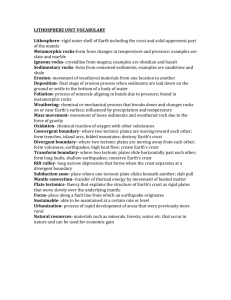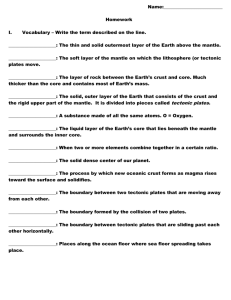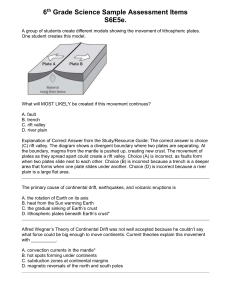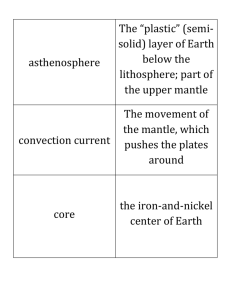geo vocab study guide 1
advertisement
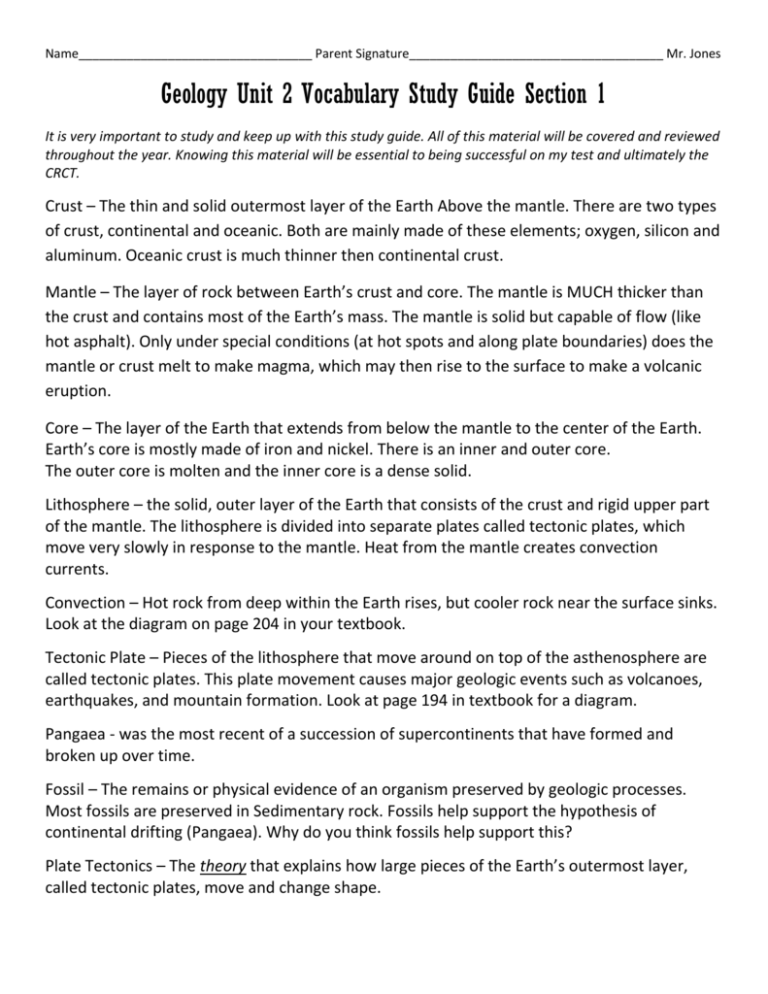
Name__________________________________ Parent Signature_____________________________________ Mr. Jones Geology Unit 2 Vocabulary Study Guide Section 1 It is very important to study and keep up with this study guide. All of this material will be covered and reviewed throughout the year. Knowing this material will be essential to being successful on my test and ultimately the CRCT. Crust – The thin and solid outermost layer of the Earth Above the mantle. There are two types of crust, continental and oceanic. Both are mainly made of these elements; oxygen, silicon and aluminum. Oceanic crust is much thinner then continental crust. Mantle – The layer of rock between Earth’s crust and core. The mantle is MUCH thicker than the crust and contains most of the Earth’s mass. The mantle is solid but capable of flow (like hot asphalt). Only under special conditions (at hot spots and along plate boundaries) does the mantle or crust melt to make magma, which may then rise to the surface to make a volcanic eruption. Core – The layer of the Earth that extends from below the mantle to the center of the Earth. Earth’s core is mostly made of iron and nickel. There is an inner and outer core. The outer core is molten and the inner core is a dense solid. Lithosphere – the solid, outer layer of the Earth that consists of the crust and rigid upper part of the mantle. The lithosphere is divided into separate plates called tectonic plates, which move very slowly in response to the mantle. Heat from the mantle creates convection currents. Convection – Hot rock from deep within the Earth rises, but cooler rock near the surface sinks. Look at the diagram on page 204 in your textbook. Tectonic Plate – Pieces of the lithosphere that move around on top of the asthenosphere are called tectonic plates. This plate movement causes major geologic events such as volcanoes, earthquakes, and mountain formation. Look at page 194 in textbook for a diagram. Pangaea - was the most recent of a succession of supercontinents that have formed and broken up over time. Fossil – The remains or physical evidence of an organism preserved by geologic processes. Most fossils are preserved in Sedimentary rock. Fossils help support the hypothesis of continental drifting (Pangaea). Why do you think fossils help support this? Plate Tectonics – The theory that explains how large pieces of the Earth’s outermost layer, called tectonic plates, move and change shape. Continental Drift – the hypothesis that states that the continents once formed a single landmass, broke up, and drifted to their present locations. (Occurred over millions of years) Earthquake – The word earthquake defines itself fairly well. Most earthquakes take place near the edges of tectonic plates. (Seismology is the study of earthquakes) Seismic Waves – Waves of energy that travel through the Earth are called seismic waves. There are two types of waves: S waves and P waves. Scientist measure these waves. Within minutes they can give the strength, time, and the location of the earthquake. Epicenter – the point on Earth’s surface directly above an earthquake’s starting point. Fault – Is a break in the Earth’s crust along which blocks of the crust slide relative to one another. Earthquakes occur along faults because of this sliding. Plate Boundaries – A boundary is a place where tectonic plates touch. All tectonic plates share boundaries with other tectonic plates. They are divided into three groups. Convergent Boundary – Formed by the collision of two lithospheric plates. What happens at a convergent boundary depends on the kind of crust is at the leading edge of each tectonic plate Divergent Boundary – When two tectonic plates are moving away from each other. New sea floor forms at divergent boundaries. Mid-ocean ridges are an example of divergent boundaries Transform Boundary – the boundary between tectonic plates that are sliding past each other horizontally. The San Andreas Fault in California is an example of Transform boundary. Folding – The bending of rock layers due to stress. Volcano – are areas of Earth’s surface through which magma and volcanic gases pass. At this moment volcanic eruptions are occurring around the world, on the ocean floor and on land. There are nonexplosive and explosive eruptions. Page.250 known the differences Magma – Magma that flows onto the Earth’s surface is called lava. During a volcanic eruption, molten rock, or magma, is forced to the Earth’s surface.
